|
| Pip Counting |

in January of 2017 (post number 197140).
Note from Nack, Oct 2018: “I have now rewritten the explanation
of Coconut Count and have produced an extensive Practice Guide.”
In order to make the excellent half-crossover pip count concept (first written about by Douglas Zare in 2000 in this article) even faster, I developed the Kangaroo Count, first published in Flint Area Backgammon News (#277) in 2005.
It occurred to me that I could supplement Kangaroo count with colorless counting when I read the terrific Urquhart/Simborg article (2012).
Colorless Counting
It has long been known that the act of swapping two opposite-colored checkers on the board does not affect the relative pip count.
Before Swapping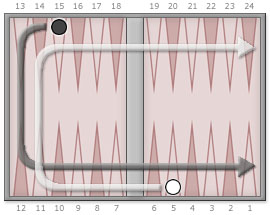 Black leads 15 to 20, ahead by 5. |
After Swapping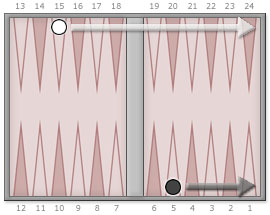 Black leads 5 to 10, still ahead by 5. |
But it was Robert Urquhart who parlayed this amusing fact (and still a revelation to some) into a pip-counting system.
In Robert’s system, Step 1 accomplishes the same thing that the “far side men” and “big diagonals” do in Kangaroo’s Steps 1 and 2, while also cleverly adding a fifteenth-checker twist to render checker color irrelevant. And the counting of the so-called “near triads” is identical to the counting of the “small diagonals” employed in Kangaroo — other than how the math manifests.
Finally, Urquhart’s Step 3 (to convert from an approximate count to an exact count) is essentially the same as the final step used in Kangaroo, which is the same as the final step in Zare’s half-crossover system.
I describe this last step as “shifting to the middles” (the second and fifth points of each quadrant) in order to clarify the process. I do not tally up a series of +1 and −1 adjustments for all eight half-quadrants. Typically all I need to actually “count” is a left-over pip or two, or no pips at all!
Some time back in the 1980’s, I was at the Monte Carlo tournament, hanging out as usual the night before with (probably) Kent Goulding, Bill Robertie, and Mike Senkiewicz. In one of these guy’s hotel rooms was an open backgammon board and he asked my opinion about a checker play. I snickered (or maybe snackered): All thirty checkers were the same color!
Or so I thought. It took me a couple of minutes to realize that the others weren’t just playing along with the joke. They could see the position and I couldn’t. This situation has never happened to that extent before or since, but I was handicapped by my partial color-blindness combined with the dim lighting and minimal color contrast of the checkers (something like maroon and brown). However, given what I know today, it occurs to me that I could have bewildered them with a comparative pip count!
Coconut Count
My new pip-count system, which is Kangaroo supplemented with colorless counting, is called “Coconut.” This word incorporates the sounds at the beginning of each of the two words “colorless counting,” which are also 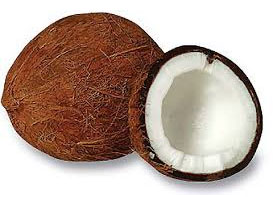 alliterative with the “K” in Kangaroo. Furthermore, the five letters of the word “count” appear in “coconut” almost in the same order.
alliterative with the “K” in Kangaroo. Furthermore, the five letters of the word “count” appear in “coconut” almost in the same order.
Finally, I (overactively) imagine coconuts might be a staple in the diet of kangaroos (which are mostly vegetarian), if they could only crack the shell. If you are nuts about the idea of colorless counting, try out Coco-nut!
The joy of Coconut (as with Kangaroo) is that you have to count only the number of checkers, not pips nor even crossovers. (And now, with the concept of colorless counting incorporated, you don’t even have to distinguish black from white.) What a load off our minds!
Yes, for the Coconut system, as with Urquhart’s, in which only the relative pip count is to be ascertained, it makes no difference what color each of the thirty checkers are. It is useful to understand, however, that black and white each have their clearly designated sides of the board, bearoff trays, and point numbers, which are often referenced. For example, there might be two checkers on white’s 7 point, but for counting purposes we don’t care one iota what color they are. They may as well be two different colors on the same point!
If you are not a mathematician, you might find it difficult to see exactly why Coconut (or Kangaroo count) works, but it doesn’t matter. Just follow the jingle below.
A Poem
The poem for Coconut is:
Then add the diagonal, and double again.
Plus slants, less one-o-five, times three.
Then shift to the middles for accuracy.
That’s if you want a “plus” number to mean that you are ahead. If you want a plus number to mean you are behind, replace “near” in the first line with “far.” In that case, the big diagonal will include the opponent’s home board instead of your own, and the “slants” (small diagonals) will include (for example) the opponent’s 1 point and 7 point, instead of your own.
The reason I have chosen to use the opposite of Kangaroo’s direction for the big diagonal and slants is that it hardly matters otherwise, and I may as well make the presentation of Coconut here a bit more compatible with Urquhart’s system (for those who want to try both).
Four Steps
Here again are those steps from the Coconut poem, spelled out longhand:
- Count the number of checkers on the near side. Double that.
- Add the number of checkers on the “big diagonal.” Double again.
- Add the number of checkers on the small diagonals, subtract 105, and multiply by 3.
- Shift to the middles (optional).
An Example
I’ve chosen a position to count, more or less at random. I clicked on the first post of a recent thread initiated by Leobueno, and it appeared that the pip count could be a relevant (or even pivotal) factor both for the cube action and the proposed checker problem in his position.
|
| Leobueno position. |
Step 1. Count the number of checkers on the near side. Double that.
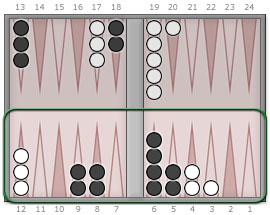
| 16 near-side checkers. |
Easy enough: 16 × 2 = 32.
Step 2. Add the number of checkers on the “big diagonal.” Double again.
The “big diagonal” encompasses our home board (where there are 9 checkers) and the opponent’s outer board (where there are 8 checkers).
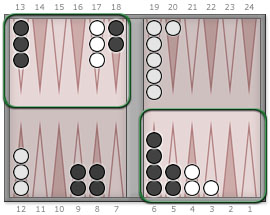
| 17 checkers on the big diagonal. |
So 32 + 17 = 49, and double that to 98.
Step 3. Add the number of checkers on the small diagonals, subtract 105, and multiply by 3.
In the Coconut poem, the word “slant” means small diagonal. There are two small diagonals: One includes the lower three points (always from black’s perspective) of the home boards (1-2-3, and 19-20-21). The other small diagonal consists of the lower three points in the outer boards (7-8-9 and 13-14-15).
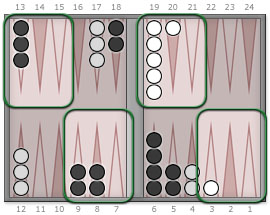
| 14 checkers on the small diagonals. |
Mentally imprint the diagonal flow of the small diagonals — it will help you remember and boost your counting speed.
98 + 14 = 112, subtract 105 becomes 7, times 3 makes 21.
Thus black leads (we lead) by 21 pips. That is the approximate count. However, this could be a position where an approximate count is not enough to ensure a proper cube decision, and an exact count might be necessary. Therefore, let’s continue to Step 4.
Step 4. Shift to the middles.
The middles are the middle points of the half-quadrants (or “triads”), which are perhaps most easily recognized as the second and fifth points of every quadrant.
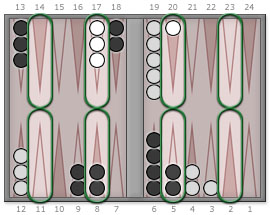
| The “middles.” |
If a checker is located on a middle, its count is zero and its job finished. What is left to do is to adjust for the checkers that are not already on their middles.
One way to account for the non-middle checkers is to add and subtract a series of 1-pip adjustments (as Urquhart implies in calling it a “unit crossover count,” and it works well enough, given that some pluses and minuses can be cancelled as you go). Relatively speaking, however, this process seems tedious to me. I prefer visual cancellation, which I find reduces the chance of error and minimizes actual “counting.” Cancellation is speedy, not difficult, and actually fun — you’ll be surprised how good you can become with practice.
Our job is to get “rid” of the non-middle checkers in a series of transactions, either by making an (offsetting) shift that moves checker(s) to a middle, or finding some way to cancel them with other checkers or groups of checkers. Mental shifting involves a couple of basic concepts and several cancellation tricks, some of which I’ll expound in more detail after you observe how I count the first position. For now, follow along as best you can.
There are many possible shifting approaches in this position, but here’s the one that jumped out at me:
- Move one of black’s 5-point checkers back to his 6 point (note the vertical symmetry), and offset by sliding a checker from the 3 point to the 2 point.
- Cancel vertically. (Checkers across the board from each other cancel themselves out.)
The five black checkers on the 6 point cancel the five white checkers directly across the board. And the checkers on the 2 point, 5 point, and 20 point are already on their middles.
The entire right side of the board has vanished except for two checkers on black’s 4 point.
- Cancel reflections, checkers equally distant from the bar. The two checkers on the 4 point cancel against the reflecting 9 point.
The checkers on both 8 points vaporize (because they are already on there middles). And the mid points vertically cancel, leaving only two surviving checkers on white’s 7 point.
Those checkers are “high” and hence count −2 (high/negative being unfavorable for black’s count). Therefore, adjust the 21 (from Step 3) by −2, for an exact difference of 19.
Black leads by 19 pips.
Tips for Mental Shifting
I promised you some tips for shifting in Step 4. If it doesn’t interest you at this time, skip to the next position.
- Horizontal shifting. For general shifting practice in pip-count systems: (a) Checkers on the same (near vs. far) side of the board can be moved equally away from each other without altering the count, a form of horizontal cancellation. (b) Checkers on opposite sides of the board can be moved in the same (left/right) direction.
Offsetting Shifts 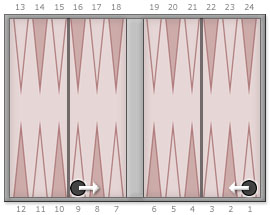
(a) Same side of board.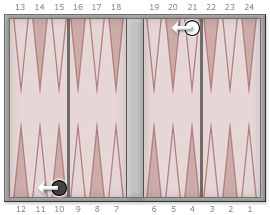
(b) Opposite sides of board.However, the edge points of the half-quadrants are sacred: Do not step over them (e.g., from the 21 point to the 22 point, or 7 point to 6 point).
- Vertical cancellation. In the shifting process, vertical cancellation is of enormous help. Recall in the position above, I moved a checker off black’s 5 point back to the 6 point to achieve a large vertical symmetry. In doing so, I made all the 6-point checkers go away (instead of removing four vs. four, which is less clean).
And also recall, without shifting at all, the mid points just disappeared like money borrowers, never to be seen again. Granted, instead I could have moved the three near-side mid-point checkers to the left, and the far-side mid-pointers likewise to the left (an equal offset), putting all six checkers on the 11-point and 14-point middles. But why go to the trouble? Vertical cancellation is instantaneous.
- Diagonal cancellation. Checkers on opposite sides of the board and exactly 3, 6, or 9 pips to the left or right of each other can be cancelled. For example, I could have chosen to cancel the anchor on black’s 4 point with the anchor on white’s 7 point.
A wider, 6-off, diagonal offset would be to cancel white’s three mid-pointers with three of white’s 6-point checkers. I briefly considered it because then the remaining two 6-pointers could go to the 5-point middle, offset by black doing the same with his two 6-point spares, and demolishing the entire (symmetrical) eight-checker block on black’s 6-5-4. My instincts may have rebelled leaving the other mid point isolated in the process, though when you gain enough speed and confidence, typically whatever you see first is best.
With practice, entire boards can sometimes empty themselves in a second or two.
Another Example
Finally, let’s use Coconut to count Position 1 of the Urquhart/Simborg article. Beforehand (or afterwards), for comparison, you might want to read their version of the count by clicking here.
Okay, here’s how the same position can be counted using Coconut:
|
| Urquhart/Simborg position. |
- Count the number of checkers on the near side, and double that. 13 × 2 = 26.
- Add the number of checkers on the big diagonal, and double again.
There are 8 + 10 = 18 checkers on the big diagonal. So 26 + 18 = 44, and double that to 88.
- Add the number of checkers on the small diagonals, subtract 105, and multiply by 3. There are only 9 checkers on the small diagonals. (Two each on white’s 6 point and 5 point, 3 on black’s 8 point, and 2 on black’s mid point.) 88 + 9 = 97, subtract 105 becomes −8, times 3 makes our count −24.
Thus, black trails by 24 pips, approximately. If you want an exact count, finish off with with Step 4.
- Shift to the middles. The mid points cancel. Black’s entire 6-5-4 group is symmetrical around its middle (the 5 point) — already done. Likewise with the 7-8-9 group on white’s side, except for the spare on the 7 point, which symmetrically cancels against one of white’s 6-point checkers, and the other 6-point checker horizontally cancels against the 1-point blot! And of course white’s 5 point and black’s 8 point are ignored because they are already at their middles.
Only two checkers survive, on white’s 3 point. They are both 1 pip low in their respective half-quadrants, so the count is +2 (i.e., in favor of black). Adding the +2 to the −24 gives the exact count. Black is behind by 22 pips.
Running the steps together:
13 × 2 = 26, + 18 = 44, × 2 = 88, + 9 = 97, − 105 = −8, × 3 = −24, + 2 = −22.
The numbers shaded in blue represent the three times you actually counted checkers and the one time you counted all of 2 pips. The rest of the numbers represent what will become routine arithmetic.
Checkers on the Bar or Borne Off
There is one more detail to clarify: What do we do with checkers that are on the bar or borne off?
Assume that you are the near-side player with the black checkers, and your opponent is the far-side player with the white checkers. For counting purposes:
- A black checker on the bar (or white checker borne off) is on the “25 point,” and does not get counted except as a 2-pip adjustment (or cancellation) in the final step.
- A white checker on the bar (or black checker borne off) is on the “0 point,” and is counted every step of the way. It is on the near side, it is on the diagonal, and it is on the slants.
The position below is a simplified selection for demonstration purposes. (If it arose in a game and for some unknown reason you wanted a comparison count, admittedly you would just visualize that black is ahead by the extra two checkers moved down to his 8 point: Black leads by 5 × 2 = 10.)
|
| 65R-54S-43K-1. |
The only time you need to pay attention to color in Coconut count (or any other colorless system) is when a checker is on the bar, because it tells you in which bear-off tray that checker is located.
In playing backgammon, if we all dutifully put the checkers we hit where they “belong,” they would be easier to count! A hit black checker would be placed in white’s bearoff tray, and a hit white checker would be placed in black’s bear-off tray. For practical reasons, we don’t do that, so it is necessary to visualize (or remember) the real location when we use the faster pip-count systems.
In the next diagram, the checkers are still on the bar. You just don’t see them there! They have been moved over to the “25 point” and “0 point” where they belong.
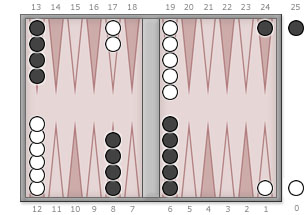
Let’s count using the Coconut poem:
- First you double the near side men.
- Okay, 17 doubled is 34.
Thus 12 is your approximate count. If you feel the need to perfect it, add the last step:
Using that to adjust the approximate count of 12 gives the exact count: Black leads by 10.
In the last step, we were fortunate that the 0-point white checker cancelled against the 25-point black checker. If that cancellation (or some other cancellation) had not been possible, you would count each checker on the 25 point as −2, or each checker on the 0 point as +2.
